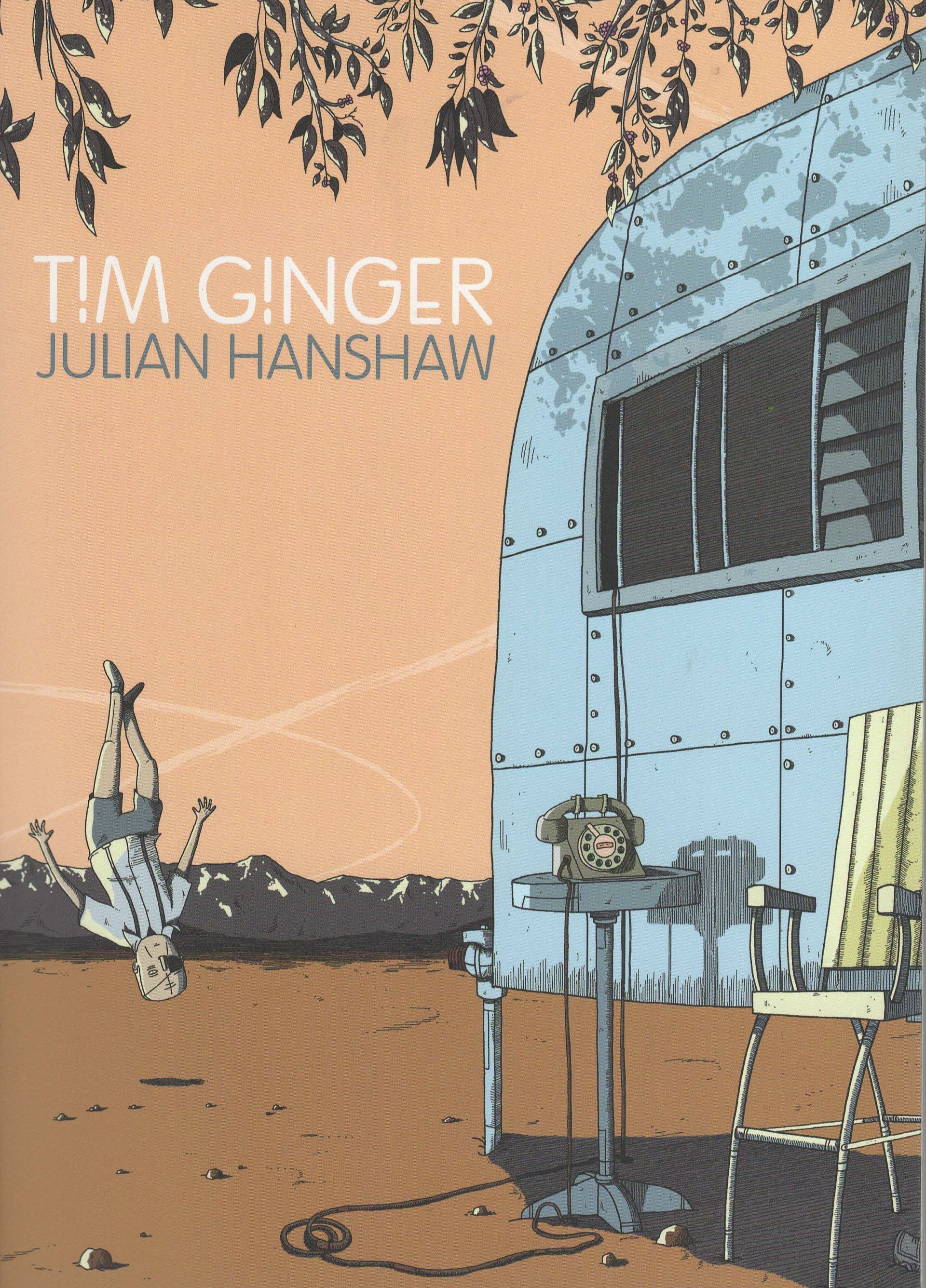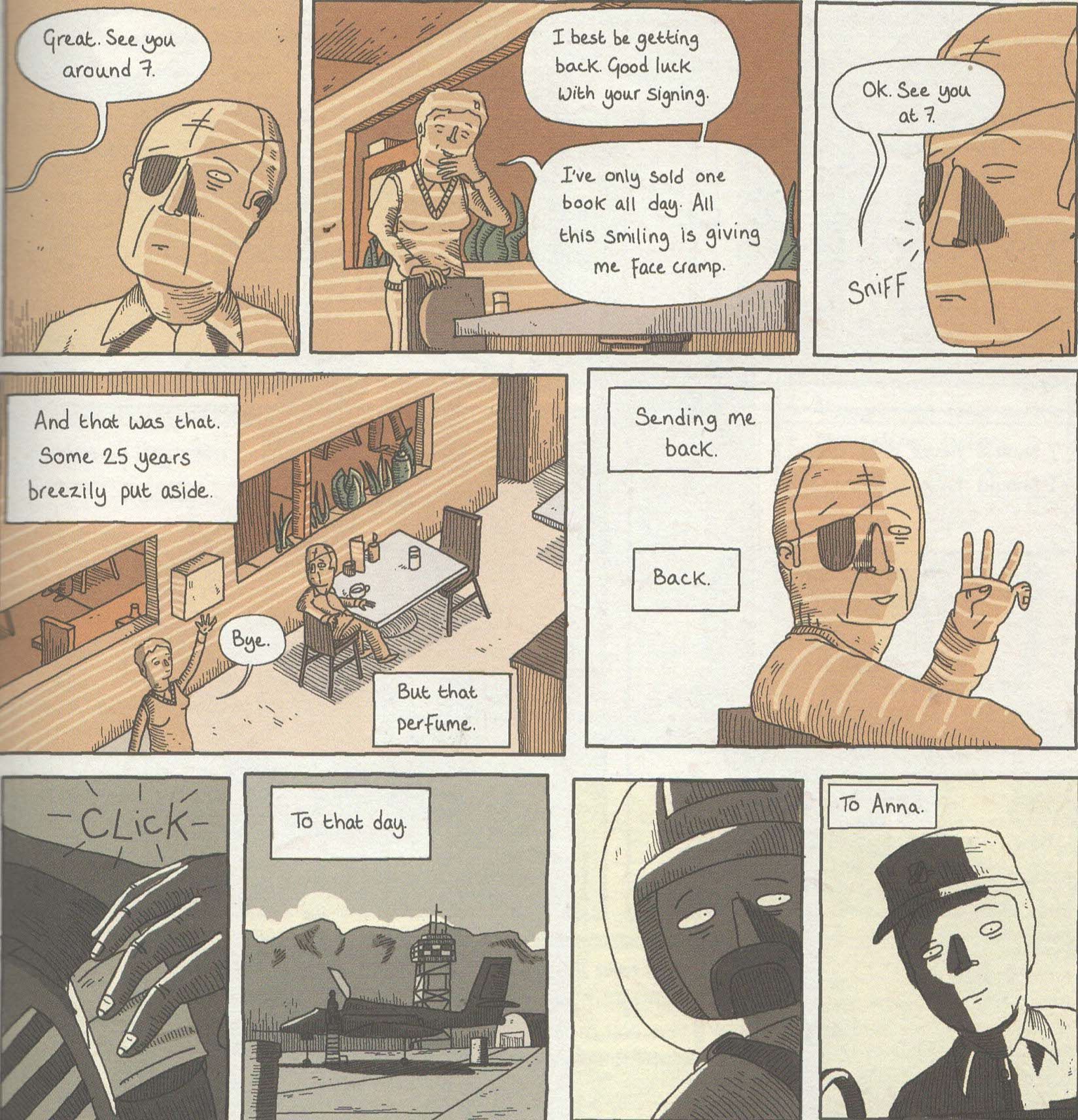"Now the light commands, this is my home - I'm coming home"
Julian Hanshaw writes and draws Tim Ginger, which is published by Top Shelf and costs $19.99. Is that Mr. Ginger there on the cover, floating upside down?
Well, of course it is, but it all makes sense once you start reading!
Considering that Top Shelf published this, it's not surprising that Tim Ginger is a singularly odd comic. I mean, that's kind of what Top Shelf does, right? Hanshaw is a bit obsessed with cricket, so Tim is too, and there's quite a bit of cricket in this book - more than you really should expect. There's a mission that goes sideways, and there's some supernatural stuff, but in the end, this is a meditation on loss. It's not exactly depressing, but some sad stuff happens. As it does.
In a book with so little action, plot becomes secondary, even though the book has a through-line that Hanshaw follows to its somewhat logical conclusion. He wants to link conspiracy theories with his main theme, which is childlessness, and he does so pretty well. Tim Ginger, who lives alone in a trailer in New Mexico, is a childless widower. Years earlier, he was a test pilot, and on one mission, something strange happened that left him with an imploded right eye and, in a roundabout way, a dead wife. In the present, he's written a book about various conspiracies, which it seems he might know something about, being a former test pilot of military planes and having experienced something odd on one test.
So he's a minor celebrity, and he's convinced to visit some sci-fi conventions, where a fan/writer tries to get information about his new book out of him and he reconnects with an old friend, whom Hanshaw sets up as a new love interest. He and Anna are sweet together, but Tim isn't ready for anything new. We think it's because he's holding onto the memory of his dead wife, but it's something a bit stranger and even more literal than that.
You might wonder what cricket, being a test pilot, and childlessness have in common, but Hanshaw manages it, because it's all about chaos versus order. It's always a fascinating dichotomy, as everyone wants order in their lives but know that chaos is always lurking, so it becomes how you handle it. Tim wants to impose order on his life, and cricket, with its strict rules, is one way to do it. Conspiracies are another way. It's no secret that conspiracies grow out of a person's inability to handle the randomness of life, and Hanshaw doesn't hammer it home, but it's still interesting to consider that. Tim is a person who craves order, and he found it in conspiracy theory but has even moved on from that to cricket. Childlessness is another way to impose order, as kids are naturally chaotic. Anna has drawn a comic in which she interviews childless couples about their decision, and many of them imply it's because of the chaos that kids bring. One woman doesn't want to go into a Chuck-E-Cheese, which is a crazy place. Another doesn't want a trampoline in her backyard.
Another hates crazy children on planes. All of these chaotic events are missing from their lives, and that's fine with them. The subjects of Anna's book, Anna, and Tim himself are looking for quietude, and they find it where they can. Tim and Susan, his dead wife, bonded over not wanting children, and he bonds with Anna over the same thing. After his wife died, he found order in conspiracies, then cricket, but Hanshaw does an interesting thing by showing that you can't completely excise chaos from your life, and perhaps it's not always a bad thing. Early in the book, Tim's agent convinces him to go to a few conventions, which throws him out of his comfort zone and into the orbit of others, including Anna. Later in the book, Tim has to embrace a bit of chaos so he can finally let Susan go - her death was a shard of chaos jutting into his carefully ordered life. Hanshaw juxtaposes her death with Tim's odd experience on his mission, which haunts him still. That small bit of chaos in his life spurs him on, and it's interesting that while he craves a life of order, Hanshaw points out that chaos is inescapable and is the impetus for positive (and negative, of course) change. The overall theme of childlessness is interesting, because while the childless people in the book have order in their lives and they aren't unhappy, it's interesting to note that they're also rather staid, and Hanshaw doesn't judge that, but he shows how Tim slowly (very slowly; the book is fairly languid) comes to shift his ideas just enough to allow the smallest bit of chaos into his life. Hanshaw also does something clever by linking Tim's conspiracy past to childlessness. Despite Tim's lack of children, he has created, through his book, a group of people who look upon him as a role model.
Karl, a fellow conspiracy theorist, is the embodiment of this cult, and he becomes upset when Tim tells him his next book will be about cricket (Hanshaw makes it a fun joke, as Karl doesn't realize Tim is talking about the game and thinks he's using code, until he is later disabused of this notion). Karl isn't Tim's child, of course, but the idea of a role model letting us down because he or she doesn't conform to what we think they should be doing is a classic trope about parents and kids, and Hanshaw cleverly puts it into the book to show that even when you are childless, you can't always escape the life cycle of a parent.
Hanshaw does some interesting things with the artwork, too. He's very detailed, but in a simplistic way, if that makes sense. He doesn't use a lot of lines to create his art, so it looks sparse until you begin to look at it more closely. His prosaic work for most of the book helps set Tim's odd experience on his mission apart - Hanshaw's style doesn't change that much, but he bends and stretches his line work to make it look far more unusual, and while it's brief, it makes the scene very memorable. He uses small panels throughout the book, and it's an interesting choice, as it makes the New Mexico desert look more claustrophobic than it actually is (the Southwest is many things, but it's definitely not claustrophobic). This creates an artistic match to the way Tim has circumscribed his life, and Hanshaw, consciously or not, uses slightly bigger panels when Tim goes on the road, showing how his world is expanding ever so subtly.
He uses interesting colors, too, from nice pinks to show morning in the desert to earthier tones when Tim finally relaxes when he meets Anna outside the convention, from the dreary blues of England to the brighter blues of the desert sky. In a "realistic" comic like this, which takes place in actual places and stars "real" people, the use of lighting can't be underestimated, and Hanshaw's use of shading is excellent - when the characters are outside, we always know where the sun is, and when they're inside, he uses the shadows to evoke a strange, poorly-lit world that the conspiracies theorists inhabit, making Tim's choice to live in the desert seem even smarter. The artwork is quietly effective, much like Hanshaw's writing, and it makes the book more prosaic, which makes the themes Hanshaw is exploring more meaningful.
Tim Ginger is an unusual book, but it's a good one. You shouldn't expect too much excitement when you read it, but you should expect to be forced to think about the choices we make in life, whether they're the right ones, and whether we should break out of the molds we make for ourselves. Hanshaw judges no one, which is nice, but he still brings up these conundrums (conundra?) and lets us chew on them for a while. There's nothing wrong with that! Plus, you get some fun conspiracy theories. Those are always keen to hash out!
Rating: ★ ★ ★ ★ ★ ★ ★ ½ ☆ ☆






